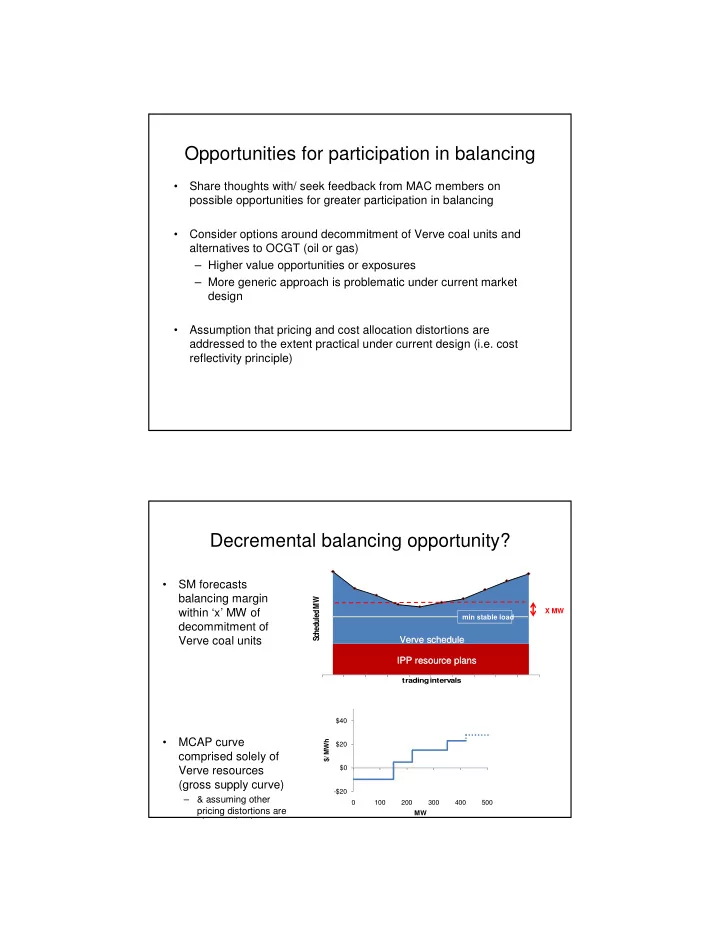

Opportunities for participation in balancing • Share thoughts with/ seek feedback from MAC members on possible opportunities for greater participation in balancing • Consider options around decommitment of Verve coal units and alternatives to OCGT (oil or gas) – Higher value opportunities or exposures – More generic approach is problematic under current market design • Assumption that pricing and cost allocation distortions are addressed to the extent practical under current design (i.e. cost reflectivity principle) Decremental balancing opportunity? • SM forecasts balancing margin Scheduled MW ‘x’ MW within ‘x’ MW of X MW min stable load decommitment of Verve coal units Verve schedule Verve schedule IPP resource plans IPP resource plans trading intervals $40 • MCAP curve $/ MWh $20 comprised solely of Verve resources $0 (gross supply curve) -$20 – & assuming other 0 100 200 300 400 500 pricing distortions are MW also resolved to extent
Decremental balancing opportunity? • SM advises market of decremental balancing opportunity/ calls for DecBSC offers from participants • Indicates total quantity, timing and expected MCAP if decommitment occurs • Participants submit DecBSC offers 1. Turn Down Tranche (TDT): • Single P-Q tranche per facility (simplifies assessments/ dispatch) • ‘Option’ which SM can request at short notice 2. Decommitment tranche DT: • P-Q, min/max times, lead time etc • Assessment more complex (need to determine how to evaluate) • If submitting DT, must submit TDT (even if zero if already at minimum) Decremental balancing opportunity? • SM notifies participants their DecBSC options(s) have been accepted • SM maintains operational communication with participants about prospects for their option(s) to be called • SM advises market it has accepted options • If required, SM would dispatch TDs first (i.e. before TDTs) • If SM calls (dispatches) DecBSCs: 1. TDT: • Eligible to set balancing price: MCAP = min(dispatched incBSC options, Verve dispatched balancing quantity) 2. DT: • Establishing MCAP tricky given lead times, multi period decisions • Will require careful analysis of approach
Incremental balancing opportunity? OCGTs OCGTs • SM forecasts balancing margin cheduled MW within ‘x’ MW of dispatching Verve OCGTs (gas or liquid) for energy S Verve schedule Verve schedule – Does not require that all slow start units be committed (e.g. because IPP resource plans IPP resource plans of min run times) trading intervals • SM announces incremental balancing support opportunity – Forecast times/ MCAP if OCGTs called – Call for IPPs to provide incremental BSC (IncBSC) offers Incremental balancing opportunity? • IPPs make IncBSC offers • 1 P-Q tranche per facility (simple assessment of offers) • Dispatchable on SM request (no lead time if called) • If SM calls (dispatches) IncBSCs: • Eligible to set balancing price (balancing price will be no less than highest price incBSC option dispatched • Insert called IncBSCs into MCAP curve, adjust relevant quantity
Why not a more generic approach? • Generic participation (under current balancing arrangement) will threaten market efficiency: – e.g. IPP renominations (of resource plans ) potentially invalidates gross commitment and dispatch of Verve as balancer
Recommend
More recommend